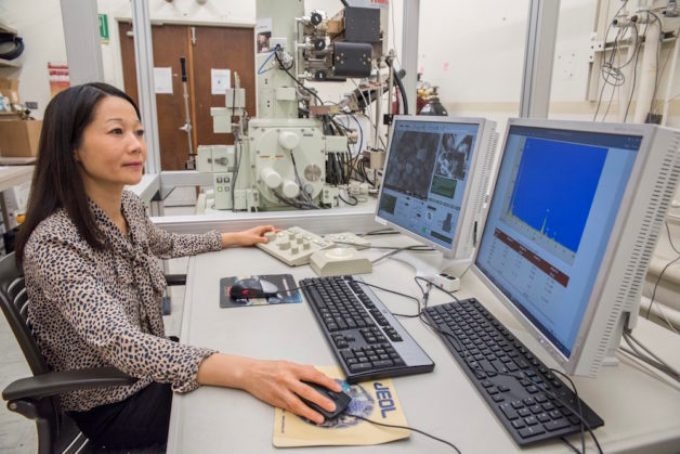Feb 2 2017
 Berkeley Lab researcher Guoying Chen (Credit: Marilyn Chung/Berkeley Lab)
Berkeley Lab researcher Guoying Chen (Credit: Marilyn Chung/Berkeley Lab)
Researchers at the Department of Energy’s Lawrence Berkeley National Laboratory (Berkeley Lab) have used advanced imaging techniques to observe what happens within a cathode particle while lithium-ion batteries are charged and discharged.
In a research project headed by Guoying Chen, a Berkeley Lab materials chemist, the investigators revealed important insights into reactions in cathode materials, including the finding of particle cracking as the cathode is charged, which can decrease battery life and capacity. The research article titled, “Phase Transformation Mechanism in LiMn1.5Ni1.5O4 Cathode Particles Revealed by Single-crystal Hard X-ray Microscopy”, was published today in the journal Nature Communications.
Understanding dynamic reaction pathways in solid matter and the phase transformation mechanism is extremely difficult but critical in designing advanced materials—not just battery cathodes but materials for other applications as well. The uniqueness of this work was the combination of using high-resolution two-dimensional and three-dimensional imaging techniques on single-crystal materials.
Guoying Chen, Materials Chemist, Berkeley Lab
Phase transformation, which takes place when lithium comes out of the particles while the battery is being charged or goes back when discharged, holds the solution to how quick and how many times a battery can be cycled.
Chen selected a lithium manganese nickel oxide cathode for this study, because it is considered as one of the next-generation battery materials. “Its higher energy comes from its unique high charge and discharge voltage, but the high voltage also provokes enhanced reactivity from the electrolyte and leads to a less stable battery,” she said.
The scientists used transmission microscopy imaging in combination with X-ray absorption analysis to examine a series of samples they had prepared in the lab.
Instead of using commercial grade particles, which often have built-in variations, we made single crystals in the lab of a few microns in size. With our samples we could carry out analysis based on observation of individual particles without worrying about contributions from other random factors not in our control, such as grain boundaries and porosity.
Guoying Chen, Materials Chemist, Berkeley Lab
The scientists mapped out the phase and chemical distribution on their particles at an extremely high spatial resolution. These maps offer “fossil evidence” of the phase transformation, which enabled them to achieve extraordinary mechanistic understanding of the electrode material.
During the study, they saw a unique nucleation and growth process that simultaneously involved multiple phases on the same particle. The influence of the volume differences between the phases, a total decrease of more than 6%, caused the particles to crack. This became more significant when the particle approached the fully delithiated state.
Chen asserts that the cracking is probably one of the primary causes of the fade in long-term battery cycling that scientists have seen with this cathode.
If you have cracking, it means fresh surface keeps getting exposed, thus causing more reactions with the electrolyte, which consumes the electrolyte and reduces the lifetime of the battery. If we can minimize or eliminate the cracking issue, we probably will see much improved stability.
Guoying Chen, Materials Chemist, Berkeley Lab
The scientists are exploring two ideas to reduce the cracking, using smaller particles and preventing fully charging the particles. “Reducing particle size can be tricky as it also increases the surface area,” Chen said. “Higher surface area means more side reactions to begin with, so it is important to find the optimal size.”
Meanwhile, Chen said that her team is also searching for other methods for high-energy batteries, such as materials that can deliver a high capacity. “The approach we developed here is broadly applicable for designing and optimizing both new and existing electrode materials,” she said.
The imaging was done at SLAC National Accelerator Laboratory’s Stanford Synchrotron Radiation Lightsource (SSRL), a Department of Energy (DOE) Office of Science User Facility. SSRL scientists Yahong Xu and Yijin Liu were co-authors of the paper, as was former Berkeley Lab postdoctoral fellow Saravanan Kuppan. The work was funded by DOE’s Energy Efficiency and Renewable Energy Office.